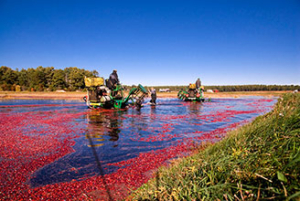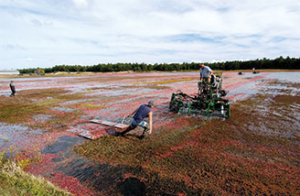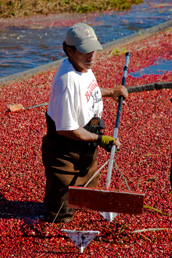The A.D. Makepeace Company, founded in 1854, is one of the world’s largest cranberry growers, and the largest private property owner in Massachusetts. We are known as a responsible steward of the land we own, all of which is located in southeastern Massachusetts.
The Cranberry Growing Industry
We’re all getting a better understanding of the role of cranberries in reducing the risk of heart disease, cancer, and other conditions, and this increased awareness has resulted in strong cranberry sales and new products.
 With more than 400 growers producing nearly 25 percent of the nation’s cranberry supply, cranberries are the number one food crop in Massachusetts, having a crop value of $50 million. The cranberry industry provides an estimated 5,500 jobs and contributes more than $200 million to the Massachusetts economy.
With more than 400 growers producing nearly 25 percent of the nation’s cranberry supply, cranberries are the number one food crop in Massachusetts, having a crop value of $50 million. The cranberry industry provides an estimated 5,500 jobs and contributes more than $200 million to the Massachusetts economy.
The A.D. Makepeace Company and The Cranberry Industry
Makepeace and its subsidiaries have been in the business of growing cranberries since the 1800s, when Abel D. Makepeace established hundreds of acres of bog across southeastern Massachusetts and became known as “The Cranberry King.” Today, the company farms some 1,750 acres of bog in the towns of Carver, Middleborough, Plymouth, Rochester and Wareham. A.D. Makepeace is the largest grower-owner of Ocean Spray Cranberries, Inc., and the largest cranberry grower in the world.
 The A.D. Makepeace Company continues to expand its cranberry operations. We recently received state and local approval to construct a new 140-acre bog in the area known as Frogfoot, in Plymouth near the Carver town line. Unlike many of the century-old bogs we currently farm, which are irregularly shaped and therefore less efficient, the new bogs will be rectangular, and can make use of advances in irrigation automation.
The A.D. Makepeace Company continues to expand its cranberry operations. We recently received state and local approval to construct a new 140-acre bog in the area known as Frogfoot, in Plymouth near the Carver town line. Unlike many of the century-old bogs we currently farm, which are irregularly shaped and therefore less efficient, the new bogs will be rectangular, and can make use of advances in irrigation automation.
Learn more about the bog project here.
Growing Cranberries
 The cranberry, along with the blueberry and Concord grape, is one of only three native fruits grown commercially in North America.
The cranberry, along with the blueberry and Concord grape, is one of only three native fruits grown commercially in North America.
Cranberries were first used by Native Americans who discovered the berry’s versatility as a food, fabric dye, and healing agent. The name “cranberry” derives from the Pilgrim name for the fruit, “craneberry,” so called because the small, pink blossoms that appear in the spring resemble the head and bill of a sandhill crane.
Cranberries grow on low lying vines in impermeable beds layered with sand, peat, gravel, and clay which were originally created by glacial deposits. Commercial bogs use a system of wetlands that provide a natural habitat for a variety of plant and animal life.
 The cranberry season begins in winter when growers flood the bogs with water that freezes and insulates the vines from winter kill. As the winter snow melts and spring arrives, the bogs are drained. Shortly thereafter blossoms begin to appear.
The cranberry season begins in winter when growers flood the bogs with water that freezes and insulates the vines from winter kill. As the winter snow melts and spring arrives, the bogs are drained. Shortly thereafter blossoms begin to appear.
In mid-July, petals fall from the flowers leaving tiny green nodes which, after weeks of summer sun, become red, ripe cranberries.
Cranberries are typically harvested in October. We flood the bogs with water, then use water reel harvesting machines that loosen the cranberries from the vine. With small air pockets in their center, the cranberries float to the water’s surface. We corral the berries for delivery to Ocean Spray processing plants.
Visit Us
Click here to learn more about tours at the A.D. Makepeace Company’s property in southeastern Massachusetts.
Sustainable Agriculture
For the past 10 years, the A.D. Makepeace Company has engaged in an aggressive bog renovation program, renovating older, lower producing bog systems with newer varieties that allow for a higher yield. The practice of renovating is critical for sustainability, not only economically but environmentally, as it enables us to manage water more efficiently.
Our commitment to sustainable agriculture goes beyond the bog.
- For every acre of cranberry bog, we maintain three times that in uplands that include wetlands, woodlands, sand, water, and other natural resources.
- We maintain numerous bluebird boxes and herring runs throughout our property.
- We are supportive of SEMAP, the Southeastern Massachusetts Agricultural Partnership, as well as the Cape Cod Cranberry Growers’ Association and the Cranberry Research Station, all of which share information about agricultural practices and opportunities.
- We share information with NCRS, CCCGA, and University of Massachusetts. We typically have several research projects on the property during the year.
On the bog, we use a varierty of non-chemical methods to manage insect pests whenever possible. For example:
- Late water floods affect many insects in the year of the flood. Emergence of insects is delayed and often synchronous (all individuals hatching over a short period of time rather than spread out over several weeks).
- Summer floods (mid-May to mid-July) can be used to control grubs, and in fact is the only method short of bog renovation.
- Detrashing floods and sanding are important in the management of certain pests.
- Conservative fertilizing in the early spring prevents pests which thrive on lush greenery.
When necessary, pesticides are used to reduce the variety of insects which are naturally attracted to cranberries. All pesticides must be tested and registered for use with the Environmental Protection Agency and the Commonwealth of Massachusetts. Certified and licensed applicators must complete yearly training requirements to maintain their license or certification. All of the Makepeace employees who apply pesticides have these annual certifications or licenses.
Visit Us
Click here to learn more about tours at the A.D. Makepeace Company’s property in southeastern Massachusetts.
A Bog In Your Backyard
Cranberry cultivation is a year-round effort, with interesting and often picturesque activity happening in every season.
IN WINTER and early spring, the A.D. Makepeace Company team will apply a layer of sand to select bogs, either using barges on flooded bogs, or buggies when the bogs ice over. The application of sand strengthens root systems and cuts down susceptibility to pests, and enables us to reduce the amount of fertilizer and pesticides we need to help the cranberry vines thrive.
IN LATE SPRING and early summer, the bogs will be covered in a blanket of tiny white flowers. We rent bees to help with pollination, and are constantly testing new methods of doing this.
THE FALL is the time most people associate with cranberries.
 The harvest takes place from mid-September through early November. There are two methods of harvesting cranberries.
The harvest takes place from mid-September through early November. There are two methods of harvesting cranberries.
Dry Harvesting
Dry harvesting involves using walk-behind machines to rake the berries off the vines into boxes or bags. Berries are removed from the bogs by either bog vehicles or helicopters. The fruit is delivered to fresh fruit receiving stations where it is graded and screened based on color and ability to bounce (soft berries will not bounce). Dry harvested cranberries are used to supply the fresh fruit market. These cranberries are most often used for cooking and baking.
Wet Harvesting
All of Makepeace’s cranberries are harvested by the wet harvest method, as are most cranberries these days.
Cranberries have pockets of air inside the fruit. Because of this, cranberries float in water, and thus, the bogs can be flooded to aid in removal of fruit from the vines. Water reels, nicknamed “egg-beaters” are used to stir up the water in the bogs. By this action, cranberries are dislodged from the vines and float to the surface of the water. Wooden or plastic “booms” are used to round up the berries, which are then lifted by conveyor or pumped into a truck to take them to the receiving station for cleaning. Wet harvested cranberries are used for juices, sauces, or as ingredients in other processed foods.
